![]() ‡2
‡2
![]() ‡n
‡n
![]() Aidés
- Helpmates
Aidés
- Helpmates
![]() Féeriques
- Fairies
Féeriques
- Fairies
![]() Retros
Retros
| D5 - Abdelaziz
ONKOUD Problemesis 2000 |
1.Df4? [2.d5‡] mais 1...c×d4! 1.d5? [2.Df4‡] mais 1...c×b4! 1.Df3! [2.D×d3‡] 1...g×f3 2.d5‡ 1...R×d4 2.Df4‡ 1...c×b4 2.T×b4‡ 1...c×d4 2.Dc6‡ |
||
 |
|||
| ‡2 | (9+8) C+ | ||
| D6 - Abdelaziz
ONKOUD Problemesis 2000 |
1.f×g3? [2.Df2‡] mais 1...c2! 1.Da1? [2.Da4‡] mais 1...g×f2+! 1.Ff1! [2.De3‡] 1...g×f2+ 2.D×f2‡ 1...c2 2.Da1‡ |
||
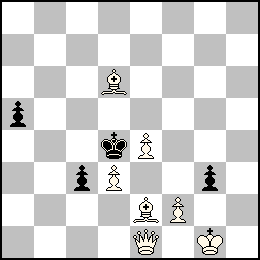 |
|||
| ‡2 | (7+4) C+ | ||
| D7 - Abdelaziz
ONKOUD Problemesis 2000 |
1.T×h5? [2.T×f5‡] mais 1...e×f3! 1.F×c7? [2.F×d6‡] mais 1...d3! 1.Cf6! [2.Cd7‡] 1...f×g4 2.T×h5‡ 1...d5 2.F×c7‡ 1...e×f3 2.Te1‡ 1...d3 2.Fc3‡ |
||
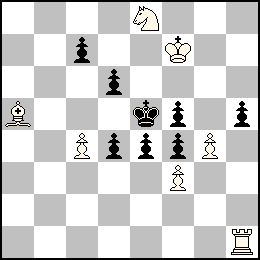 |
|||
| ‡2 | (7+8) C+ | ||
| D8 - Abdelaziz
ONKOUD Problemesis 2000 |
1.e×d7? [2.De6‡] mais 1...Fa2! 1.c×d7? [2.Fc6‡] mais 1...T×f4! 1.Rd6! [2.Dd5‡] 1...d×c6 2.F×c6‡ 1...d×e6 2.D×e6‡ 1...T×f4 2.De2‡ 1...Fa2 2.Dd3‡ |
||
 |
|||
| ‡2 | (8+6) C+ | ||
| M1 - Ralf
KRATSCHMER Problemesis 2000 |
1.Te2? [2.T8×e5,T2×e5‡] mais 1...T×h4‡! 1.Fb1! [2.Fe4‡] c3 2.Fa2+ Tc4 3.Te2 [4.T8×e5,T2×e5‡] T×h4+ 4.Rg6 [5.T8×e5,T2×e5‡] e4 5.f×e4‡ |
||
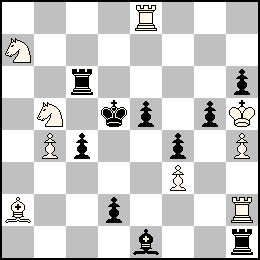 |
|||
| ‡5 | (9+10) C+ | ||
| A one-liner with obvious key (very few palatable choices for 1st move)
(Ryan McCracken)
Weil der Name des Autors ueber dem Diagramm steht, habe ich fuer die Loesung nur 2 Minuten gebraucht. Die Staerke dieser Berlinthema-Darstellung ist sicherlich die direkte Form der thematischen Fluchtfeldgabe, die nur dank der Fesselung funktionieren kann. Schwaechen gibt es allerdings auch, wobei mich die Doppeldrohung am meisten stoert. (Manfred Rittirsch) |
| H42 - Jacques
ROTENBERG Problemesis 2000 |
a) 1.a3 Cd3 2.a×b2 Ce5 3.b1=F Tg2 4.Fh7
Cf7‡ b) 1.Rg7 Re2 2.Rf6 Rf3 3.Re5 Ta5+ 4.Rd4 Ce2‡ |
||
 |
|||
| h‡4 | (4+2) C+ | ||
| b) -Pa4 | |||
| Zum huebschen Eckmustermatt mit Umwandlungslaeufer gesellt sich ueberraschend ein respektloses Idealmatt in der Brettmitte. (Manfred Rittirsch) |
| H43 - Nikolaj ZUJEV Stepan P. TSIRULIK Problemesis 2000 |
1.Fd6 Tg3 2.Ff4 Rc5 3.Ce5 Cd6‡ 1.Fc5 Tf7 2.Fe3 Rd6 3.Cd4 Cc5‡ |
||
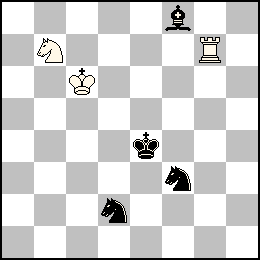 |
|||
| h‡3 | (3+4) C+ | ||
| 2.1.1... | |||
| very symmetrical play (Ryan McCracken) |
| H44 - Paul VATARESCU Emanuel NAVON Problemesis 2000 |
1.Td5 C×g4 2.Rd4 Db4‡ 1.Rf3 Cf5 2.Tf4 Dh1‡ 1.Rf4 Cf7 2.Te4 D×f2‡ |
||
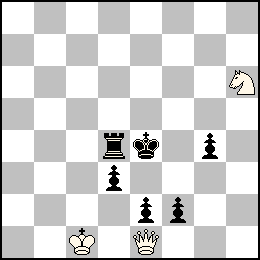 |
|||
| h‡2 | (3+6) C+ | ||
| 3.1.1.1 | |||
| 3 nice mates (Ryan McCracken)
Das schoenste Mattbild muss auch in diesem gelungenen Dreispaenner das seltenere bleiben. (Manfred Rittirsch) |
| H45 - Michel
CAILLAUD Problemesis 2000 |
1...Ce6 2.Ce5 Cg5‡ 1.Cg5 De2+ 2.Rf4 Ch5‡ 1.f4 Dc2+ 2.Re3 Cf5‡ |
||
 |
|||
| h‡2* | (3+3) C+ | ||
| 2.1.1.1 | |||
| Black's lack of tempo moves causes the mate pattern to shift from
set to play...very nice with good economy (Ryan McCracken)
Dreifach (und dann natuerlich auch mit Farbwechsel) kann man dieses Echo (vgl. Kb3 Dg5 Se6 - Kd6 Sb6 Bd7 - h#2* - Wilhelm Kraemer, Schachmatt 1948) nur noch als sensationell bezeichnen! (Manfred Rittirsch) |
| H46 - Jacques
ROTENBERG Problemesis 2000 |
1.g4 Cd5 2.Re4 Te8+ 3.Rf5 Te5‡ 1.g4 Cd6 2.Re5 Te8+ 3.Rf6 Cce4‡ 1.Rd3 Cd5 2.Re4 Te8+ 3.Rf5 Cce3‡ |
||
 |
|||
| h‡3 | (4+2) C+ | ||
| 1.2.1.1... + 1.1... | |||
| H47 - Jacques
ROTENBERG Problemesis 2000 |
1.Re4 Tf5 2.Cf2 Cc2 3.Cd3 Cg3‡ 1.Cg3 Tf6 2.Cf5 Cc3 3.Cd4 Cg4‡ |
||
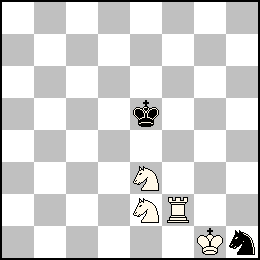 |
|||
| h‡3 | (4+2) C+ | ||
| 2.1.1... | |||
| H48 - Jacques
ROTENBERG Problemesis 2000 |
1.Cd2 Cc2 2.Cb3 Td5+ 3.Rc4 Ce3‡ 1.Cc3 Td6 2.Cd5 Cc3 3.Cb4 Ce4‡ |
||
 |
|||
| h‡3 | (4+2) C+ | ||
| 2.1.1... | |||
| H49 - Olivier
RONAT Problemesis 2000 |
1.Fa8 Tc3 2.Db7 Cc4 3.Dh1 Ce3 4.Fg2 Cg4‡ | ||
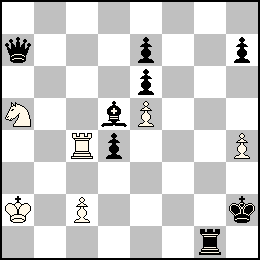 |
|||
| h‡4 | (6+8) C+ | ||
| unexpected and beautiful bristol motivated by need to unpin white
pieces and close bR line (Ryan McCracken)
Waere der Loydsche Einleitungszug nicht so verlockend gewesen, haette ich dieses abwegige Mattbild wohl noch sehr, sehr lange gesucht! (Manfred Rittirsch) |
| F19 - Gianni
DONATI Problemesis 2000 |
1.d4 3.Rc3 7.d8=D 8.D×h4(Dd8) 9.Df2 14.h8=D 15.Dhd4 17.Re1 18.Dd1+ D×d1‡ | ||
 |
|||
| ss‡18 | (3+2) C+ | ||
| Circé | |||
| Mit zwei Damenumwandlungen gelingt der Zweifachexzelsior (Vgl. F15 vom gleichen Autor) sogar in Idealoekonomie. (Manfred Rittirsch) |
| F20 - Reto
ASCHWANDEN Problemesis 2000 |
1.CPc5? A
[2.LO×b2-c3‡] 1...TP×c5(CPa6) a 2.CP×c5‡ A 1...FPe6 b 2.C×d6‡ B 1...LI×f3 c 2.TLPe6‡ C mais 1...g4! 1.TLPe6! C [2.TLf5‡] 1...TPc5 a 2.C×d6‡ B 1...FP×e6(TLPg6) b 2.TLP×e6‡ C 1...LI×f3 c 2.CPc5‡ A |
||
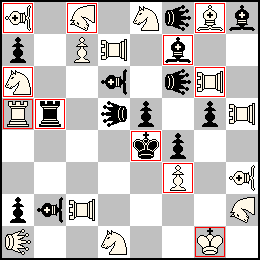 |
|||
| ‡2 | (17+14) C+ | ||
| Circé
diagramme blanc # =Pièce Patrouille g=Girafe lL=Fou-Lion U=Lion wxW=Locuste y=Tour-Lion |
|||
| 1.Sc5 ? A threat 2.Lxb2-c3 # Intercepts the observation line wRLc2-c8 to wGIc8. Doublecheck threat by wSc5 and wPf3. 1...Rxc5[+wSa6] a 2.Sxc5 # A bLId5 is necessarily pinned by the wLLa8 and the wPf3. Ra5 patrols wSc5. 1...LIxf3 b 2.RLe6 # B 2.Lxb2-c3+ ? 2…Bc4 ! Both bRb5 and bBLf7 unpatrolled. d4 is covered in the mate by the wRLd7. This is necessary, because the wGIc8 doesn't guard d4. (Both observations wRLc2-c8 and wBLh3-c8 intercepted). 1...Be6 c 2.Sxd6 # C 2.RLxe6+ ? 2...Kd4! dual avoiding. Intercepts the observation line bBLh3-c8, so there's initially flight d4. The move 2.Sxd6 patrols wGIc8 again, so d4 guarded. Both bLocusts have lost guard of d6. but: 1…g4 ! Flight d4.
1.RLe6 ! B threat 2.RLf5 #
Pioneer example of the above Key Reappearance Theme. Lacný and
Reversal 1 included. I've talked about these themes in my lecture in Pula.
For more details, read my upcoming feenschach article. |
| F21 - Olivier
RONAT Problemesis 2000 |
a) 1.GSRd4(+b7) b8=GS 2.GSRh8(+d4) GSe5‡ 1.GSRa7(+b7) b8=D+ 2.GSRh1(+a7) a8=GS‡ b) 1.GSRa6(+c7) c8=F+ 2.GSRa7(+a6) Fb7= 1.GSRb5(+c7) c8=D 2.GSRa7(+b5) Dc6= |
||
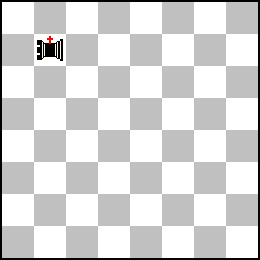 |
|||
| h‡2 | (0+1) C+ | ||
| 2.1.1.1 b) >Yb7®c7, h=2 Sentinelles en Pion adverse < =Pièce Royale Y=Girl-scout |
|||
| F22 - Olivier
RONAT Problemesis 2000 |
1.BSRc7(+b4) b5 2.BSRb2(+c7) c8=D 3.BSRa1(+b2)
Dc1‡ 1.BSRa7(+b4) b5 2.BSRc7(+a7) a8=C+ 3.BSRa7(+c7) b6‡ 1.BSRc3(+b4) b5 2.BSRb2(+c3) b6 3.BSRa5(+b2) b4‡ |
||
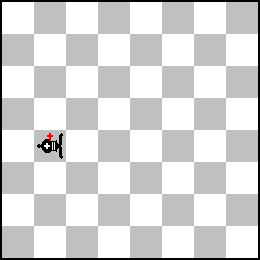 |
|||
| h‡3 | (0+1) C+ | ||
| 3.1.1... Sentinelles en Pion adverse < =Pièce Royale L=Boy-scout |
|||
| R25 - Michel
CAILLAUD Problemesis 2000 |
1.f3 e5 2.Rf2 Df6 3.Rg3
Da6 4.Rh4 D×e2
5.g3 Df2 6.Fa6 e4 7.d3 e3 8.Cd2 e2 9.Cb3
e1=D 10.Fg5 De7 11.De2
Dfe3 12.Tf1 Dd8 13.Cc1
Dee7 14.D×e7+
Echange de place de la DN et du PNe7 - bQ and bPe7 interchange their
place |
||
 |
|||
| Partie justificative en 13,5 coups | (15+15) C+ | ||
| Die bis auf den Themabauern vollstaendige sPAS und die Tatsache, dass die beiden Themasteine vor dem letzten Einzelzug einem ordentlichen Platzwechsel genuegt haben, verleihen diesem D-Pronkin Letztformcharakter. (Manfred Rittirsch) |
| R26 - Gianni
DONATI Problemesis 2000 |
1.h4 h5 2.Th3 Th6 3.Tb3 Tc6 4.Tb6 a×b6 5.Cc3 Ta3 6.Ce4 Tac3 7.d×c3 e6 8.Fh6 D×h4 9.Dd2 Fe7 10.Td1 Ff6 11.Dc1 Re7 12.Cd2 Rd6 13.Cb1+ Rc5 14.Td3 d6 15.Th3 Fd7 16.Th1 Dh3 17.Dd1 h4 18.Fc1 | ||
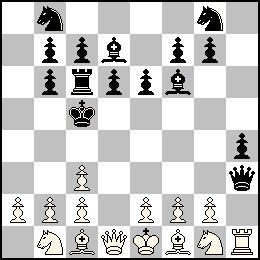 |
|||
| Partie justificative en 17,5 coups | (14+15) C+ | ||
| Besonders gut tarnen konnte sich der a-Turm nicht, aber er kommt sauber durch alle Teamkameraden "hindurch", und als Zugabe findet die S-Rueckkehr ueberraschend in Form eines Rundlaufs statt. (Manfred Rittirsch) |